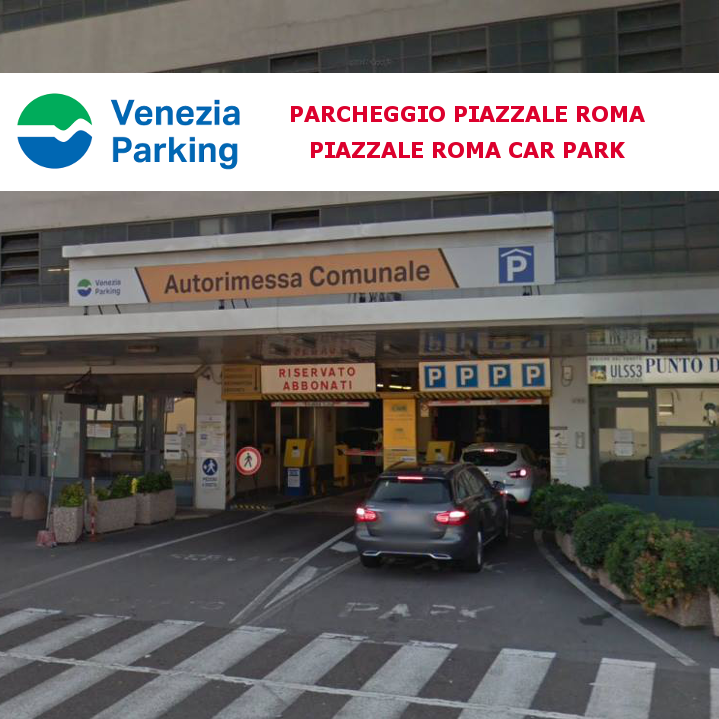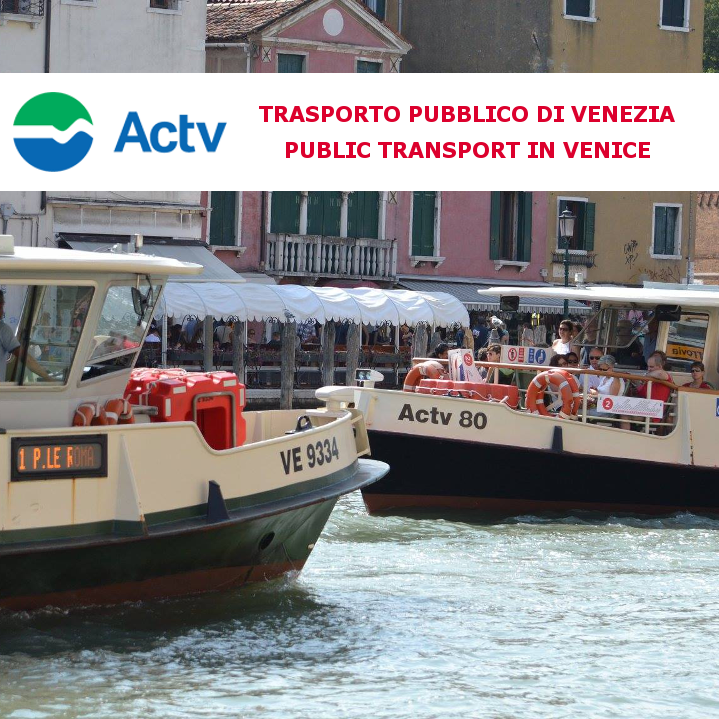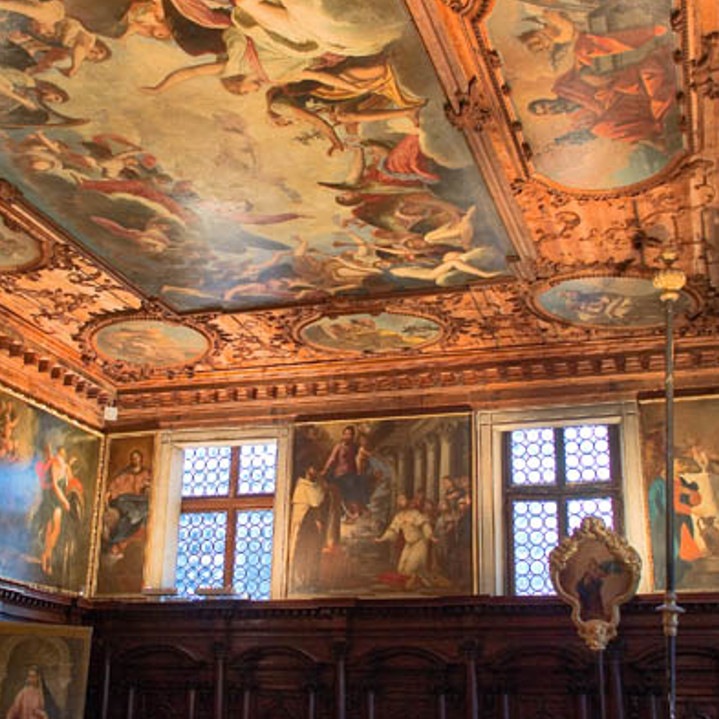You are here
Unmissable masterpieces and breathtaking views in an elegant and bohemian district
Unmissable masterpieces and breathtaking views in an elegant and bohemian district
This itinerary takes place in the sestiere (district) of Dorsoduro, from Ponte dell'Accademia to Campo Santa Margherita, highlighting three artisan stores: Le forcole, rowlock and oar workshop, Ca' Macana, shop and workshop for papier mâché handmade masks (which has two locations not far from each other), and Signor Blum, handmade wooden objects and toys.
In the course of the tour, it will be possible to learn about facts and aspects of the history of the city. Some the most important complexes that can be visited are the church of Santa Maria della Salute, Ca' Rezzonico and the Scuola Grande dei Carmini.
The name Dorsoduro, literally hard ridge, seems to derive from the fact that this part of the city was developed on higher and and more stable ground than elsewhere. The area was however further extended by means of land reclamation works that are evident especially in the first part of our itinerary in the area of Punta della Dogana, where a series of parallel and straight rii (small canals) connect the Grand Canal with the Giudecca Canal. You can visit three handicraft workshops, where the first one makes oars and poppets, the second one makes and sells its own handmade papier-mache masks, while the third one offers hand carved ornaments.
The Site “Venice and its Lagoon” has been inscribed on the World Heritage List since 1987 due to its Outstanding Universal Value, therefore it belongs to all of us: it is our common duty to respect it and preserve it so that it may be passed on to future generations.
The cultural heritage of the Site goes beyond the walls of palaces, churches, beyond islands and the lagoon, but is also memory, identity, community, all fundamental elements for the its vitality.
For this reason, in 2017 the City launched the #EnjoyRespectVenezia campaign with the aim of raising awareness of tourist impact among visitors and inviting them to maintain polite and correct behavior during their stay, respecting the city and its inhabitants: it is important, for example, to walk keeping to the right, not to stop and sit on bridges, not to feed the pigeons, to observe a behaviour in keeping with the place you are visiting.
- Duration: about 3h30/4h00 (with the museum visit of Ca' Rezzonico the duration will be about 4H30/5h00)
- Lenght: 4,5 km
- Mode of travel: the itinerary takes place entirely on foot
- Recommended period: all year round
- Accessibility: people with reduced mobility are advised to take vaporetto line 1 from the Accademia stop to Ca' Rezzonico. Or if you do not want to miss the visit to the rowlock workshop, you can take the vaporetto line 1 from the Salute stop to Ca' Rezzonico
- Departure: Ponte dell’Accademia
- Arrival: Scuola Grande dei Carmini in Campo Santa Margherita
-
Major attraction and highlights:
1) Accademia Bridge
2) Basilica di Santa Maria della Salute and Dogana da Mar
3) Riva delle Zattere with the Gesuati Church
4) The San Trovaso area
5) Campo San Barnaba
6) Ca’ Rezzonico
7) Scuola Grande dei Carmini - Venetian cuisine: On your stroll along calli and campielli you can find some typical Venetian taverns called "bacari", where you can eat the "cichetti". These are snacks mostly based on fish, served on bread or polenta with small portions of "sarde in saor", “baccalà mantecato” (that is creamy cod), eggs, shrimp, various salami and more besides. The “cicchetti” are always strictly accompanied by an "ombra", that is a good glass of wine. On your way you could find other traditional restaurants such as “osterie" and the "trattorie" serving genuine Venetian cuisine, such as appetizers made of various "cicchetti", pasta, "risi e bisi": that is risotto with peas, or even a fish risotto, as well as delicious spaghetti with clams. As a second course you can taste the "sarde in saor or liver cooked the Venetian way, "baccala’ mantecato, or polenta served with the "schie", grey shrimps caught in the Venetian lagoon,all accompanied by a good glass of wine
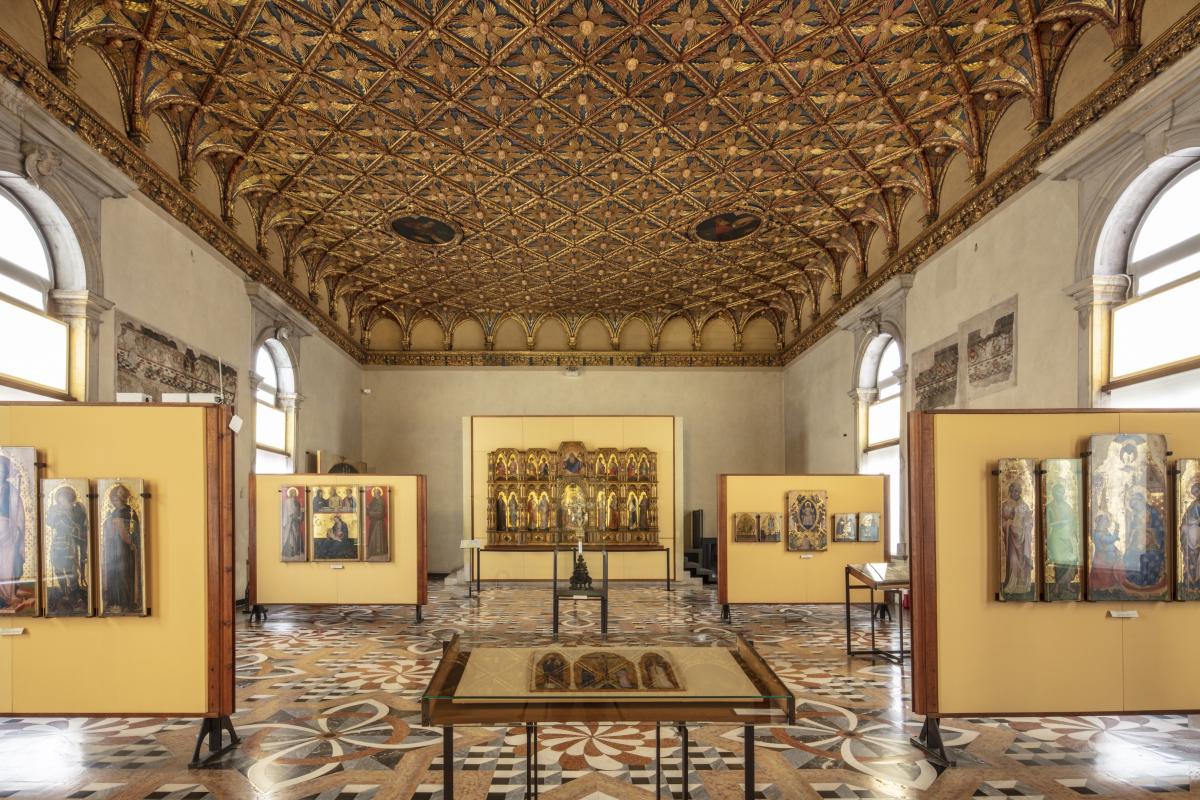
Gallerie dell'Accademia
ph. Giorgio Bombieri - Comune di Venezia
Listen to the audio tour

Collezione Peggy Guggenheim
ph. Gabriele Vattolo - Comune di Venezia
Starting point: Accademia Bridge
The walking tour starts at the foot of the Accademia Bridge, the second oldest bridge spanning the Grand Canal after the Rialto Bridge.
This "temporary" wooden bridge was built in 1933 to replace the steel one dating back to the time of the Austrian domination (1853), which presented serious problems of deterioration, but has never been replaced.
Opposite the bridge, on the right, the Galleries of the Academy of Fine Arts are located in the monumental complex once occupied by the convent and church of Santa Maria della Carità together with the Scuola (confraternity) by the same name following the Napoleonic dissolution of the monasteries, which in 1806 affected many religious buildings. It was in this way that many altarpieces, narrative cycles and other works from these or other suppressed public buildings went to form the collections of the Galleries, which therefore offer us a valuable overview of Venetian art from the fourteenth to the early nineteenth century.
Let's start our tour and, especially in the narrow streets leading to the Salute, let's not forget to keep to the right so as not to obstruct the traffic flow.
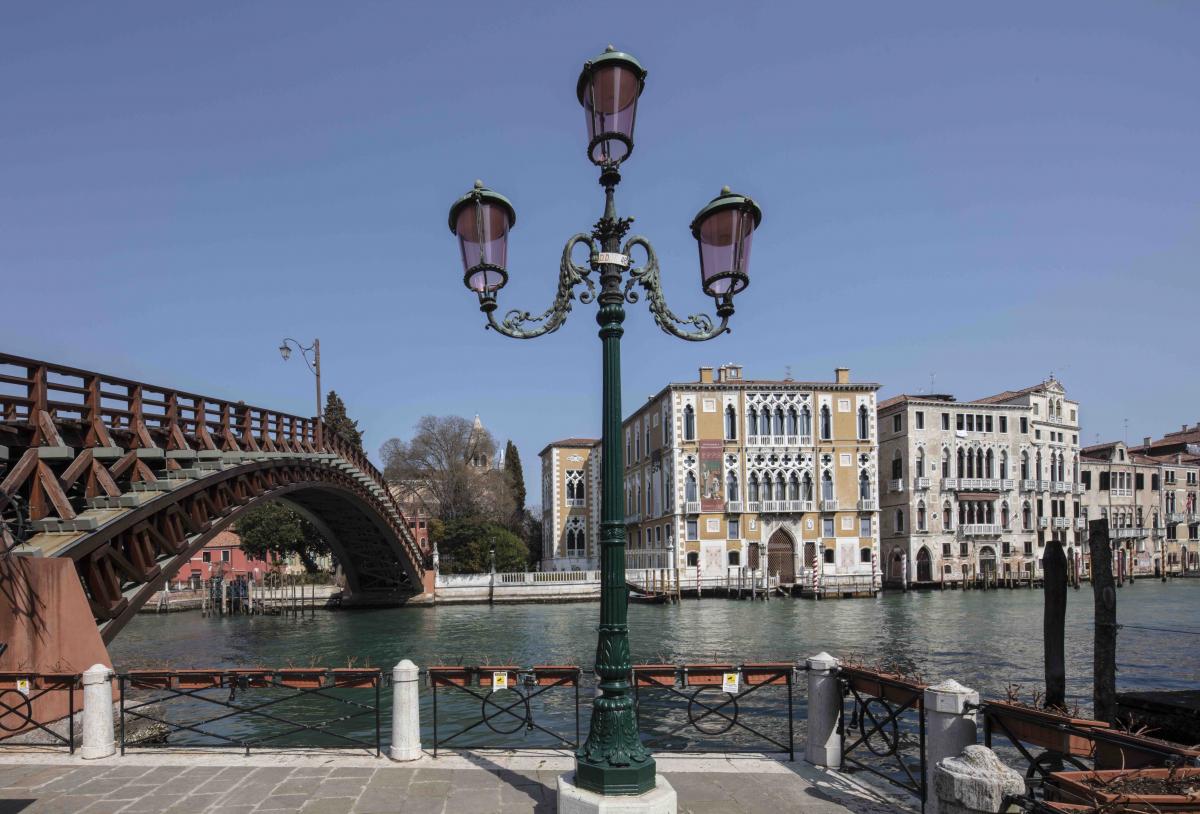
Ponte dell'Accademia
ph. Giorgio Bombieri - Comune di Venezia
Stage 1: From the Accademia Bridge to the first artisan workshop producing rowlocks and oars (25 minutes)
Continuing along the itinerary we arrive at campo San Vio (St. Vitus, Vito in Italian), dominated by the 16th century palazzo Loredan, purchased in 1919 by Vittorio Cini, entrepreneur, politician and refined collector. His house-museum is open to the public.
In the square, a small oratory stands on the site where the church dedicated to Saints Vitus and Modestus, popularly known as S. Vio, used to stand and to which the doge would pay homage in one of his 'andate' (solemn visits) on June 15, the feast of the titular saints. On the long side of the square, the evangelical church erected in memory of the English soldiers who fell on the Italian front in the 'great war', is dedicated to St. George, shown in relief above the entrance.
We continue along Calle della Chiesa as far as Fondamenta Venier, which takes its name from Palazzo Venier dei Leoni, so called because of the lion heads that decorate the facade overlooking the Grand Canal. The imposing, unfinished eighteenth-century building was purchased by Peggy Guggenheim on the occasion of the exhibition of her collection at the Biennale of Contemporary Art in 1948. The great collector and patron lived here until her death. The Guggenheim Foundation offers a panorama of top-notch 20th century art.
A few more steps along Calle della Chiesa take us to Campiello Barbaro where, behind the wall of the garden, we can see the typical truncated cone chimneys and the 'liagò' (covered terrace) of Ca' Dario, one of the most famous and at the same time mysterious palaces in Venice. The facade of the building facing the Grand Canal is decorated with precious marble inlays, typical of the taste of the early Renaissance, while the the back of the building still shows echoes of the Gothic tradition.
Walking further on, we quickly reach Fondamenta Soranzo,where you will find LE FORCOLE, the workshop of Saverio Pastor. The fórcola is the rowlock, the support on which the oar pivots when rowing standing Venetian-style and has different shapes for each type of boat. The annexed shop also offers beautiful reproductions of these objects in 'souvenir' sizes.

Ca' Dario
ph. Gabriele Vattolo - Comune di Venezia
Stage 2: Church of Santa Maria della Salute and Punta della Dogana (25 minutes)
Retracing our steps, we cross the bridge over the rio and continue along Calle del Bastion. Immediately ahead is the beautiful Gothic facade of the former parish church of S. Gregorio, once served by the Benedictine monks of the nearby Abbey, of which only a beautiful cloister, rarely open to the public, remains. On leaving the canal-side passageway of the Abbey, the white bulk of the Salute appears before our eyes. The grandiose baroque church was built by Baldassare Longhena to fulfil the vow of the Senate to the Virgin Mary for the deliverance of Venice from the terrible plague of 1630. On November 21, the feast of Our Lady of Health, the doge would visit the the church as a sign of gratitude to the Virgin in a solemn procession, crossing the Grand Canal on a pontoon bridge. This feast, very dear to the Venetians, is still repeated today in a similar fashion. Inside, our attention is drawn to the spectacular high altar by Giusto Le Court framing the precious icon of the Mesopanditissa, which Francesco Morosini brought back from Candia in 1670, after the island's fall to the Turks. In Greek, the expression means the mediatrix.
Once back in the square, on our right we can see the large building of the Maritime Customs House, the Dogana da Mar, rebuilt at the end of the 17th century and dominated by a tower on which the statue of Fortune rotates. Fallen into a long period of disuse and neglect, it has been skillfully restored by the Japanese architect Tadao Ando, and since 2009 has been used as an exhibition venue for François Pinault's important collection of contemporary art (open only during exhibitions). We continue to the Punta, one of the most scenic places in Venice: a splendid view of the San Marco basin will open up before our eyes. To this magical place the great French writer, Jean D'Ormesson, dedicated one of his Venetian novels, 'Douane de mer', the starting point of one of his imaginary otherworldly journeys.
At Punta della Dogana, on the side facing the Giudecca Canal, in 1923, the Magistrato alla Acque di Venezia installed the first station for the survey of the tide levels. Since 1983 it has been active as the tide centre of the City of Venice, providing the data on which the tide forecasts, indispensable for the life of the city, are based.
Campo della Salute
ph. Giorgio Bombieri - Comune di Venezia
Stage 3: Riva delle Zattere and Chiesa dei Gesuati (30 minutes)
Let's resume our walk along the Riva delle Zattere, a name that recalls the timber rafts that used to be floated down the Piave River all the way to the lagoon. The Riva is divided into several sections that in turn take their name from the buildings that line the quays:
· 'Saloni' the ancient salt deposits, one of the main sources of Venetian wealth
· Spirito Santo, from the church and the Scuola of the Holy Ghost suppressed by Napoleonic decree
· Incurabili, a hospital founded by St. Gaetano Thiene in 1522 to receive syphilis sufferers, soon opened to incurable patients of all kinds and later an orphanage, which quickly became one of the most celebrated places for the music that the 'putte', the young female orphans, performed in the church built in the courtyard by Jacopo Sansovino and unfortunately demolished in the nineteenth century. Currently the complex is used as the home of the Academy of Fine Arts. Fondamenta degli Incurabili is also the Italian title of Watermarks, a slim, intense book by the Russian writer Josif Brodskij, Nobel Laureate for Literature in 1987. When reading it, one discovers a Venice that has nothing to in common with tourist stereotypes, but rather becomes a place of the soul, almost a metaphysical city.
Along the fondamenta we continue in the direction of the Gesuati church, past the bridge and campiello della Calcina where the historic Pensione Calcina still stands, formerly the warehouse of the calcineri, the lime merchants and now a hotel. In the course of time the building has hosted many famous people, including, in 1877, the important English man of letters John Ruskin, author of the famous 'The Stones of Venice'.
Further on, on the right, we see the large white facade of the Church of the Gesuati, the Jesuates, an order suppressed in 1668, whose convent and church then passed to the Dominicans. The Dominicans decided to build a new monumental complex and commissioned architect Giorgio Massari to design it. The church, built between 1726 and 1737, represents one of the most homogeneous examples of the Venetian 18th century, both from an architectural and a decorative point of view. Splendid is the ceiling painted by Giambattista Tiepolo rdepicting the Institution of the Rosary and the canvas of the Apparition of the Virgin to three female saints painted by the artist for the altar of the first chapel on the right.

Chiesa dei Gesuati
ph. Gabriele Vattolo - Comune di Venezia
Stage 4: From the Gesuati to the first mask workshop (30 minutes)
Leaving the Church of the Gesuati, we continue for a short distance along the Riva delle Zattere.
Before reaching the bridge, we turn right into Fondamenta Nani. Across the canal, some wooden buildings remind us of an Alpine village: it is the squero di San Trovaso, one of the oldest boatyards still active in the construction and servicing of gondolas, immortalized in millions of photographs and postcards. The boatyard can be visited upon booking.
The fondamenta that run along the canal are lined with large and beautiful palaces, today often converted into hotels and schools. Particularly noteworthy is the fifteenth century Palazzo Barbarigo Nani Mocenigo in Gothic style, the birthplace of two doges, Marco and Agostino Barbarigo. We cross the bridge on the left and in fondamenta Toffetti, next to the church, on the facade of the Brass house, we can notice numerous paterae, a sixteenth century bas-relief representing Vulcan with Cupid in his workshop and a medieval sculpture of a wild man of the forest. On the square by the same name, raised to contain the clay caisson used to collect rainwater for the well, is the church of San Trovaso, which takes its name from the contraction of Sts. Gervasius and Protasius. It presents two identical facades, one towards the canal and the other facing the square and was completely rebuilt at the end of the sixteenth century in Palladian style. The interior features some paintings by Tintoretto, including a "Last Supper" dated 1556. Also well-worth mentioning is the beautiful the "St. Chrysogonus on Horseback" by Michele Giambono (15th c.).
Continuing along Fondamenta Bonlini, before turning right let us stop for a moment on Ponte Trevisan to admire behind us the beautiful view of the Rio and the dome of the Gesuati church on the left. Walking along Fondamenta di Borgo, high up on a wall of the house where he lived, we can see the plaque the Municipality placed in memory of actor Cesco Baseggio, unforgotten interpreter of the great classics of Venetian theatre. Not far away, we pass the famous restaurant Locanda Montin, much loved by Peggy Guggenheim, but famous above as the location of some scenes of the beautiful and poignant film The Anonymous Venetian by Enrico Maria Salerno starring Florinda Bolkan and Toni Musante.
We take the first calle on the right (Calle del Forno) at the foot of the bridge, and through a small sotoportego we reach Fondamenta Toletta where we find the first of the two Ca' Macana mask shops. Here we can already get an idea of the great variety of models created by the imagination of the mask makers, the "maschereri", and, upon request, listen to a short introduction to mask making and the use of masks during Carnival. In order to explore further details, later on in our itinerary we will stop at the second shop, where the actual workshop is located.

Squero di San Trovaso
ph. Gabriele Vattolo - Comune di Venezia
Stage 5: Campo San Barnaba and the artisan shop of wooden objects (20 minutes)
Exiting on the left, we walk along the Fondamenta de la Toletta, which takes its name from the use of a board as a bridge over the canal and, after Calle Lombardo, we pass through the Sotoportego del Casin dei Nobili.
The Venetian casini were small apartments or even simply rooms, used by the aristocracy, but not only, to meet their mistresses, friends, discuss politics or other matters, but especially to engage in gambling, the most popular pastime of many Venetians: in 1774 there were 136 casinos! If we raise our eyes above the door on the left in the sottoportico, we can still see the peephole that was used to identify callers before the door was opened...
The next square is Campo San Barnaba, dominated by the eighteenth-century facade of the much earlier church of San Barnaba. The characteristic bell tower, which dates back to the eleventh century, is among the oldest in the city. In the film Indiana Jones and the Last Crusade, the church was used as the set for a fictional library and the square in front of it to shoot the scene in which the protagonist emerges from a manhole after fleeing fictional underground passageways.
Today, instead, the church has been converted into an exhibition hall featuring some of Leonardo da Vinci's inventions.
On the left corner of the square, our next stop is the SIGNOR BLUM handicraft shop, a magical and colourful place that transports us back to our childhood, to wooden toys... In the workshop, not far from the shop (if you book in advance you can be shown around), wooden objects, cut and painted exclusively by hand, have been produced since 1980, also on commission: magnets, bookmarks, clocks, Venetian architecture, puzzles with animals and much more.
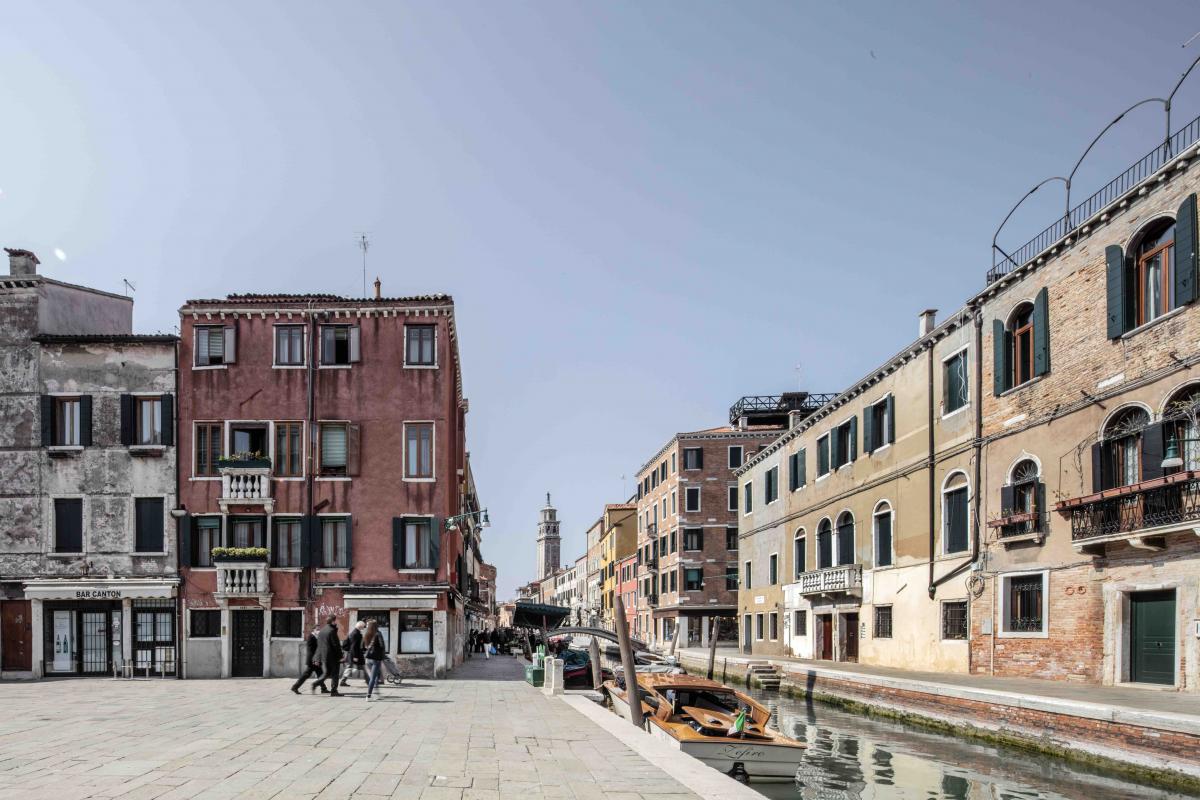
Campo San Barnaba
ph. Giorgio Bombieri - Comune di Venezia
Stage 6: Ca' Rezzonico and the second mask shop and workshop (35 minutes)
As we leave this little world of wonders, we are drawn to another colorful and peculiar sight, a boat full of fruit and vegetable crates, moored quayside since time immemorial, much loved by the Venetians who live nearby for the fresh seasonal produce available there every day. Nearby is the famous Ponte dei Pugni (Bridge of Fists), where the footprints that indicated the starting point for the fist and club fights between rival clans can still be seen. The rivalry between sestieri divided the population into two factions, the Castellani and the Nicolotti. In these brawls, fatalities were not an exception, so in 1705 the Council of Ten issued a decree, which permanently prohibited any kind of fighting.
Once we have crossed the bridge, we immediately turn right onto Fondamenta Alberti and go straight on to Fondamenta Rezzonico.
As we leave, we retrace our steps and turn right onto Calle delle Botteghe and then Calle del Fabro to reach the second CA' MACANA shop, with its adjoining mask-making workshop. Someone is always available for any questions or curiosity, but a reservation is required if you want a short presentation of the history of the mask and its use in Venice, the theatre and the Commedia dell'arte. And for those who want to learn how to decorate a mask, the artisans are happy to teach the main techniques once you book a lesson. This way, instead of buying a mask decorated by others, you can quickly take home a mask that you have personally created to your very own taste.
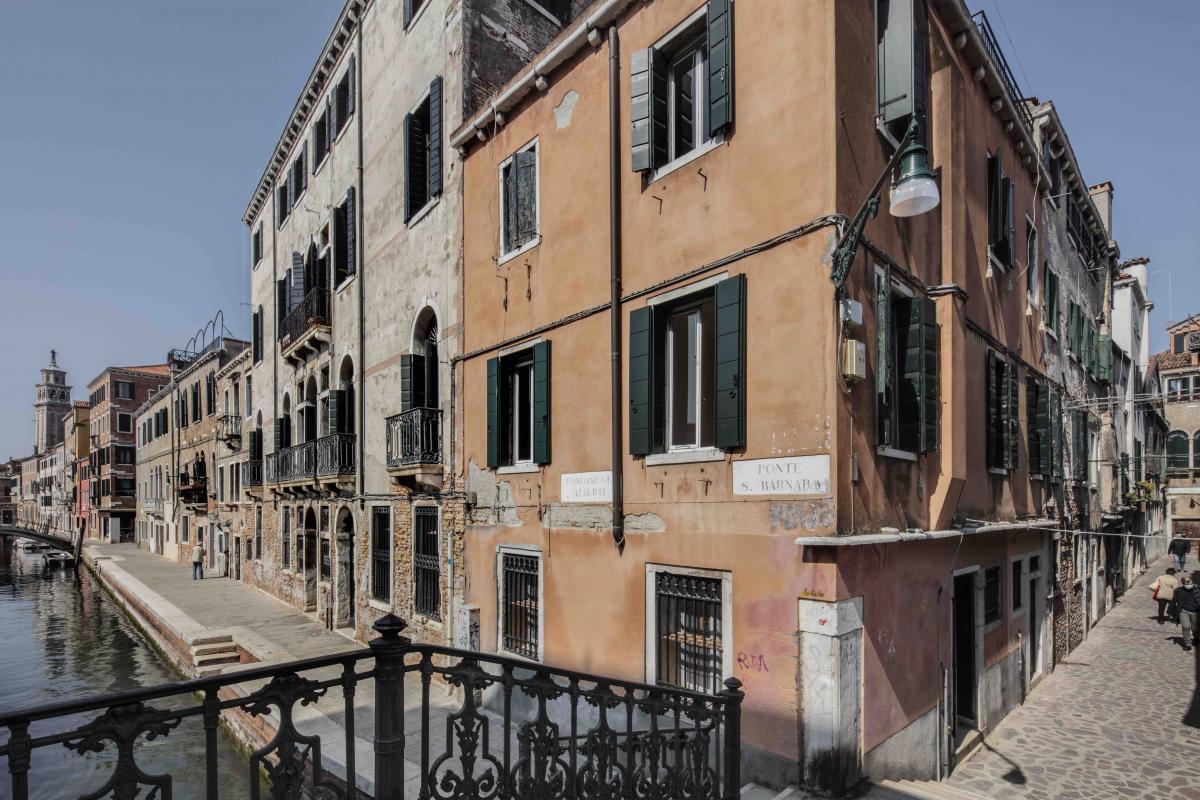
Ponte dei Pugni
ph. Giorgio Bombieri - Comune di Venezia
Stage 7: Campo Santa Margherita, Church and Scuola dei Carmini (40 minutes)
Leaving the shop, we turn right into Campiello dei Squelini, which displays the old Venetian brick pavement laid in a herringbone pattern and where a few trees still grow. The Squelini or Scudeleri were the manufacturers of bowls (scudele or squele in Venetian), and they had their furnace here. On the left walking along Calle de la Madona and then Calle de la Vida we reach Rio Terà Canal, whose name reminds us that once, what is today a street, used to be a canal, later filled in in 1862 during the Austrian occupation.
A few steps away is the huge Campo Santa Margherita, one of the most lively and popular squares in the city, busy with Venetians, university students and children.
On the right, at the end of the square, you can see the truncated bell tower of the former Santa Margherita church, now one of the lecture halls of the university. The small building at the centre of the square was the Scuola dei Varoteri, the vair furriers' guild. There are only a few patrician houses around the square and they all date from before 1300, because until the nineteenth century the area was crossed by a canal along whose banks a garbage dump was located. The two most beautiful palaces are Gothic and one has a projecting "Tuscan style" roof, a very rare example in Venice.
The monumental complex on the left of the square is definitely worth a visit: it is the Church and Scuola of Santa Maria del Carmelo, Our Lady of Mount Carmel, commonly known as the Carmini.
The Church has two entrances, one onto Campo Santa Margherita, which is the older one and is decorated with some splendid paterae, and the other one opening onto Campo dei Carmini. Built between the thirteenth and fourteenth century, the facade is instead Renaissance in style, as it was rebuilt at the beginning of the sixteenth century. The interior displays several masterpieces of Venetian Renaissance art: in particular the "Adoration of the Shepherds" by Cima da Conegliano and "Saint Nicholas between Saint John the Baptist and Saint Lucy" by Lorenzo Lotto.
Next to the church stands the Scuola dei Carmini which, compared to the other Venetian charitable institutions, was founded as a confraternity of lay women called "pinzochere dei Carmini". In 1595 men were also admitted and the diffusion of the Marian cult was so swift that in 1675 the confraternity numbered 75,000 members. The interior is one of the most beautiful examples of the Venetian 18th century architecture, in particular the magnificent staircase leading to the upper hall, whose ceiling was decorated by Giambattista Tiepolo with 'The delivery of the scapular to St. Simon Stock' and the Virtues linked to Marian symbolism.
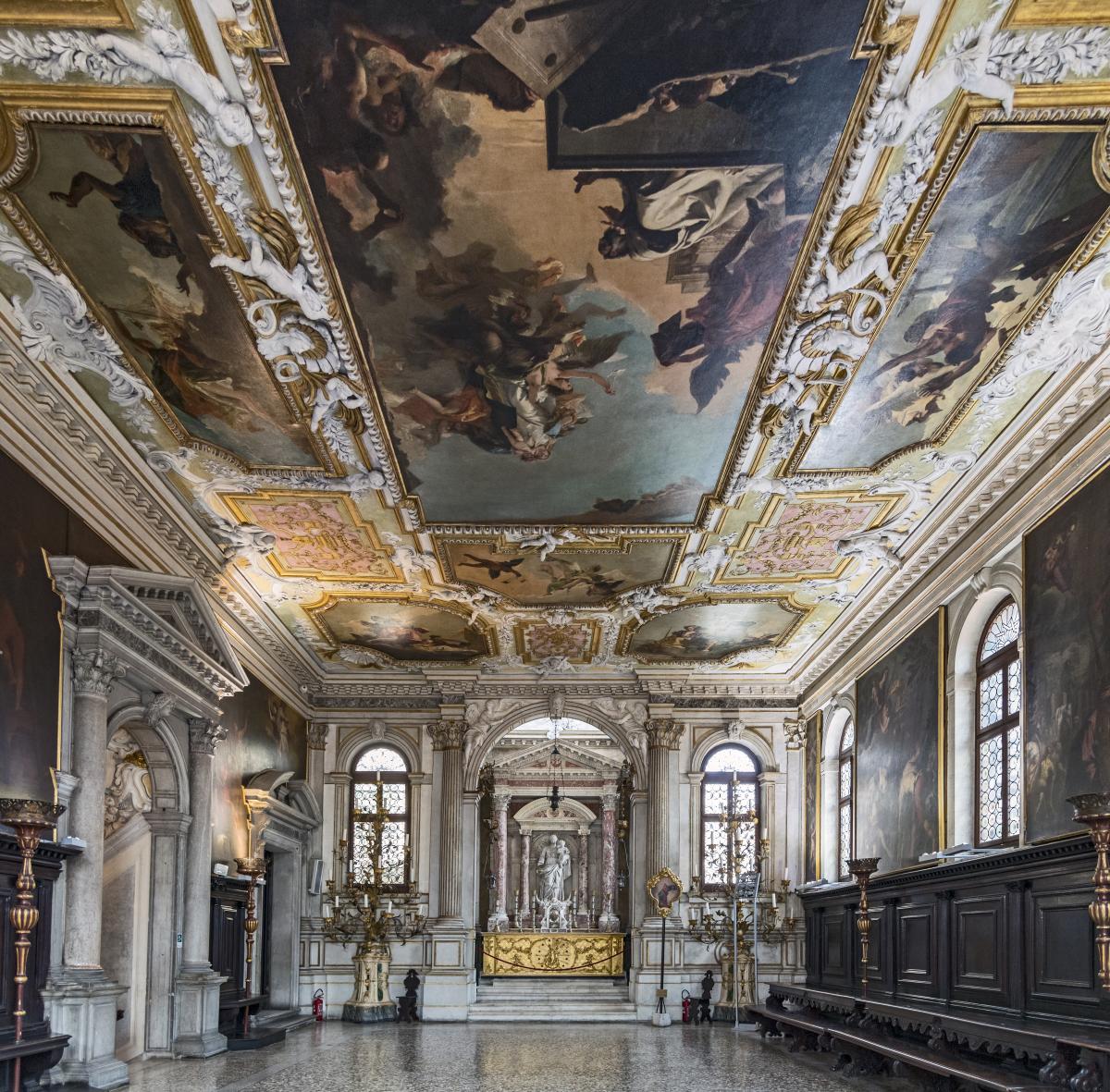
Scuola dei Carmini
ph. Didier Descouens CC BY-SA 4.0 via commons.wikimedia.org
Useful information
- Squares and rest areas: Zattere ai Gesuati and Campo Santa Margherita are equipped with benches. They are not, however, suitable for picnics, out of respect for the decorum of the city. Along the way there are all kinds of establishments offering food and drinks where you will be able to stop and rest
- Pay Public toilet facilities: the only public toilet facilities along our itinerary is at the start, at the foot of the Accademia Bridge
- Public drinking fountains: There are public drinking fountains in Campiello Barbaro, at Zattere al Ponte Lungo, in Fondamenta de la Toletta, in Campiello degli Squelini and in Campo Santa Margherita.
- High Tide walkways: only at Gesuati, between Rio Terà Foscarini and the ACTV boat stops up to the tide level of +120 cm



